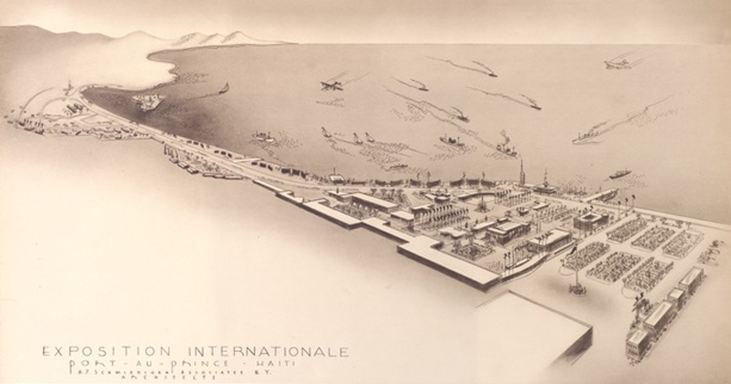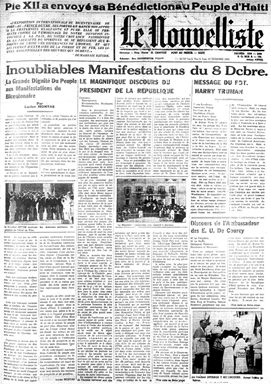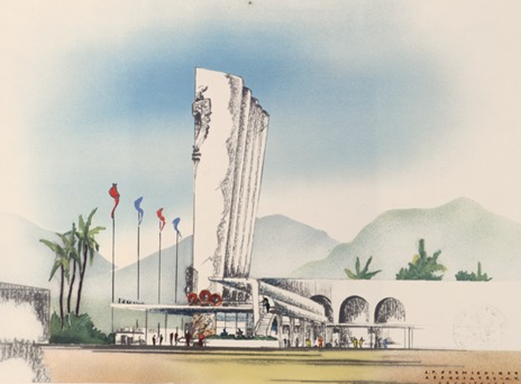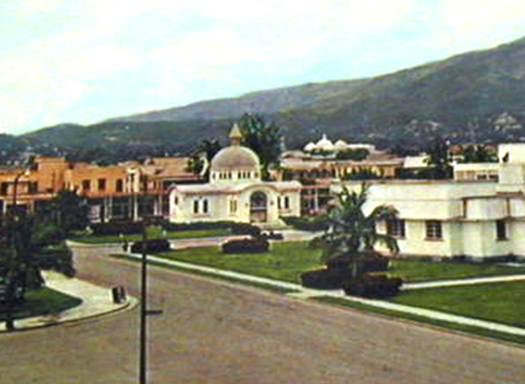"The International Exposition of Port-au-Prince, 1949-50" by Hadassah St. Hubert
St. Hubert is a doctoral candidate and McKnight doctoral fellow in the Department of History at the University of Miami. Her dissertation will examine Haiti’s participation in World’s Fairs and Expositions.
The International Exposition commemorating the Bicentennial founding of Port-au-Prince created an opportunity for the Haitian government, led by Dumarsais Estimé, to transform the capital of Port-au-Prince into a visionary "modern" city. Lasting from December 1949- June 1950, it represented a major effort by the Haitian government to advance Haitian modernity on a series of fronts including: urban beautification, international cooperation, the promotion of tourism to Haitian historical sites, and the valorization of Haiti’s national culture. The Exposition represented the Haitian government’s response to many decades of negative representations of the nation as savage and incapable. The vision of a "modern" city to the Haitian government meant better infrastructure and catering to foreign travelers by uplifting traditional Haitian culture, which included the long denigrated religious practices associated with Vodou.

At the Exposition area, also known as Cité de l’Exposition or Cité Dumarsais Estimé, visitors could walk by the newly created bay view and notice Palm trees and ponds in the Palmistes area along with a ferris wheel, an aquarium, and other attractions at the Ross Manning shows. Other sites included a cock fighting arena, Folklorique performances at Théâtre de Verdure, a tourism pavilion by the Haitian government along with smaller pavilions representing the other departments in Haiti. Whispering palms lined the principal artery named Harry S. Truman Avenue representing how the Exposition catered to U.S. tourists. The work in this area featured the work of foreign and native architects such as August F. Schmiedigen and Albert Mangonès. The participants included the U.S, France, Italy, Belgium, Spain, San Marino, Lebanon, Syria, Palestine, Canada, Venezuela, Mexico, Argentina, Guatemala, Chile, Puerto Rico, Cuba, Jamaica) participating constructed their own buildings and statues. Vatican City, the U.N. and the Organization of American States (OAS) participated in the festivities as well.
 The performers at the Exposition represented acts from throughout the region attesting to its notoriety. Théâtre de Verdure featured performances from U.S., European, Caribbean and Latin American entertainers. Participants included Irene Umilta McShine, a musician from Trinidad, choirs and dances from Spain, Cuban pianist Rosario Franco, and opera singer Marian Anderson from the U.S. The Exposition used regional entertainment for the Caribbean along with black entertainers from the U.S. Marian Anderson’s performance at Théâtre de Verdure attracted more than 3,000 spectators including Estimé and his wife. Part of the legacy of the Exposition included the formation of the Troupe Nationale Folklorique, led by Jean Léon Destiné and Lina Mathon-Blanchet, who took their performances internationally.
The performers at the Exposition represented acts from throughout the region attesting to its notoriety. Théâtre de Verdure featured performances from U.S., European, Caribbean and Latin American entertainers. Participants included Irene Umilta McShine, a musician from Trinidad, choirs and dances from Spain, Cuban pianist Rosario Franco, and opera singer Marian Anderson from the U.S. The Exposition used regional entertainment for the Caribbean along with black entertainers from the U.S. Marian Anderson’s performance at Théâtre de Verdure attracted more than 3,000 spectators including Estimé and his wife. Part of the legacy of the Exposition included the formation of the Troupe Nationale Folklorique, led by Jean Léon Destiné and Lina Mathon-Blanchet, who took their performances internationally.
As explained by historian Georges Corvington in his book Port-au-Prince au Cours des Ans (1743-1950), the Exposition, or "The Festival of Peace," commemorated the 200th anniversary of the founding of Port-au-Prince and planning started in March 1948 (Corvington, 459). This left only a little over a year to change the landscape of Port-au-Prince. The Exposition is noted for costing Haiti over $4 million of a national budget of $13.4 million (Smith, 144). However, many of the buildings at the Expositions would become part of the permanent architecture of Port-au-Prince. These buildings included the Presidential pavilion, the tourist pavilion, the post office pavilion, the agricultural pavilion, Fontaine Lumineuse, and Théâtre de Verdure (the stage for many folkloric and musical performances).


On March 1, 1950, Le Nouvelliste notes that about 70,000 total visitors were signed up to attend the Exposition. The Haitian government expected this number to grow during the Exposition and it can be safe to assume that Estime’s Exposition was exactly how Life magazine titled it: "Little World’s Fair." Unlike other World’s fairs, it did not attract millions nor did it openly admit the expectation to attract so many. Tourism was still a nascent industry and the Exposition was meant to bring Haiti international attention, a task which it achieved. The Exposition was launched with the intention to develop a "modern" city to develop a tourism industry for future decades.
Spending $4 million on the Exposition was a huge risk for the Haitian government and brought on much criticism. A coup, led by the Haitian military, was launched against Estimé’s government in May 1950. Paul Eugene Magloire was elected president in October 1950 and he continued the government promotion of the tourist industry in collaboration with Pan American Airways. Magloire was able to build on the structural changes in the capital to foster the nascent tourist industry and aided the tripling of visitors to Haiti within his regime. The international attention led his regime to be identified as part of what has been called the "Golden Age" of Haitian tourism.